The AMD 3rd Gen Ryzen Deep Dive Review: 3700X and 3900X Raising The Bar
by Andrei Frumusanu & Gavin Bonshor on July 7, 2019 9:00 AM EST** = Old results marked were performed with the original BIOS & boost behaviour as published on 7/7.
Power Consumption & Overclocking
Power consumption of the new Ryzen 3900X and 3700X are of particular interest because it’s a very key aspect of the new generation chipsets, and AMD promises some extremely large improvements thanks to the new 7nm process node as well as the optimised chiplet design.
When comparing the single-chiplet Ryzen 3700X to the previous generation Ryzen 2700X, we’re seeing quite some dramatic differences in core power consumption. In particular power consumption at each chip’s respective peak frequency is notably different: Although the new 3700X has a 100MHz higher clock speed and thus is further up the exponential power curve, it manages to showcase 32% lower absolute power than the 2700X.
We have to remember that we’re talking about overall absolute power, and not efficiency of the chip. When taking actual performance into account through the higher clock as well as Zen2’s increased performance per clock, the Performance/W figures for the new 3700X should be significantly higher than its predecessor.
What is curious about the new chip is just how closely it follows its power limitations. The new boosting algorithm on the Ryzen 3 series is a particularly “opportunistic” one that will go as high in frequencies as it can go within its constraints, no matter the amount of CPU cores.
The constraints are as follows:
- Package Power Tracking (PPT): The power threshold that is allowed to be delivered to the socket.
- This is 88W for 65W TDP processors, and 142W for 105W TDP processors.
- Thermal Design Current (TDC): The maximum amount of current delivered by the motherboard’s voltage regulators when under thermally constrained scenarios (high temperatures)
- This is 60A for 65W TDP processors, and 95A for 105W TDP processors.
- Electrical Design Current (EDC): This is the maximum amount of current at any instantaneous short period of time that can be delivered by the motherboard’s voltage regulators.
- This is 90A for 65W TDP processors, and 140A for 105W TDP processors.
Looking at the total power consumption of the new 3700X, the chip is very much seemingly hitting and maintaining the 88W PPT limitations of the default settings, and we’re measuring 90W peak consumption across the package.
When having a closer look at the new Ryzen 9 3900X, first we have to enjoy the sheer amount of cores of this processor!
Following that, we see that this CPU’s per-core peak power consumption is quite notably higher than that of the 3700X, which is not a surprise given that the chip is clocked 200MHz higher at 4.6GHz versus “just” 4.4GHz. However even at this much higher clock, the 3900X’s power consumption remains notably lower than that of the 2700X.
Scaling up in threads as well as cores, we’re seeing a similar scaling behaviour, with the large difference being that the 3900X is maintaining higher power consumption per core (and frequency) than the 3700X. Fully loading the chip we’re seeing 118W power on the CPU cores while the package power is falling in at the exact 142W that AMD describes as the PPT limit of 105W TDP processors such as the 3900X.
Another thing to note in the results between the 3700X results and the 3900X, is that un-core power on the latter is quite higher. This really shouldn’t come as a surprise as the processor has a second chiplet who will have L3 and Infinity Fabric that will use more power.
Graphing the three processors together, we see two main aspects: Again the 3900X and 3700X both consuming notably less power than the 2700X, and the 3700X’s hard limit when reaching the 88W PPT limit while the 3900X is able to scale further up till it hits the 142W limit.

Comparing the full load power characteristics of both SKUs, they end up extremely competitive in both their respective categories. The 3700X’s 90W hard-limit puts it at the very bottom of the CPUs we’ve used in our testing today, which is quite astonishing as the chip is trading blows with the 9700K and 9900K across all of our test workloads, and the latter chip’s power consumption is well over 60% above the 3700X’s.
The 3900X is also impressive given that it’s a 12-core CPU. While posting substantial performance improvements of the 12-core Threadripper counterparts, the 3900X still manages to be significantly less thermally constrained thanks to its much lower power consumption, peaking in at 142W.
The most interesting aspect of AMD’s new opportunistic power boost mechanism lies in a CPU we weren’t able to test today: the Ryzen 7 3800X. At stock behaviour, the chip’s 105W TDP should allow it to behave a lot more like the 3900X when it comes to the higher thread-count frequencies, at least until it maxes out its 8 cores on its single chiplet, which might really put it ahead of the 3700X in terms of multi-threaded performance workloads.
Overclocking: PBO & All-Core
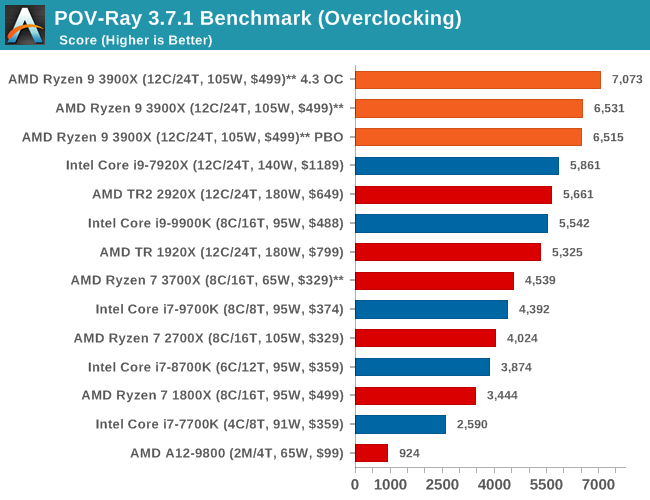
In POV-Ray, running the 3900X at a flat 4.3GHz at 1.35V gives it a 8.2% performance boost over stock. Enabling PBO doesn’t make much difference in multi-threaded workloads for the 3900X as it’s still being limited by the 142W PPT limit.
Unfortunately we weren’t able to further investigate raising the PPT limit for this article due to time contraints as well as currently non-final firmware version for X570 motherboards from the vendors.
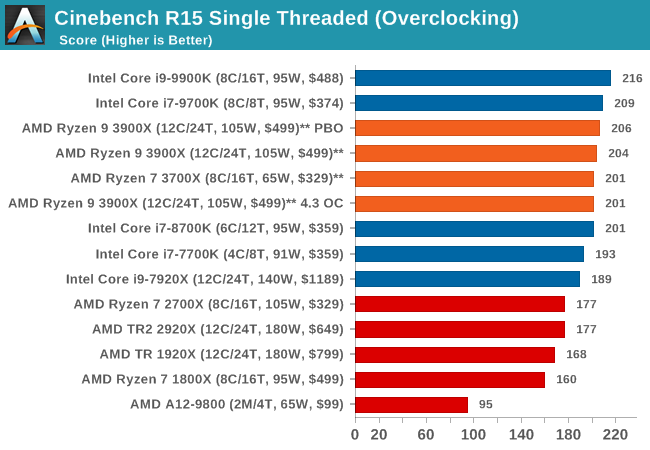
Turning on PBO will increase the single-threaded performance of the 3900X by a few percent, scoring just slightly higher than the stock settings. Naturally the 4.3 GHz flat overclock will regress in performance as it loses out 300MHz peak frequency compared to stock.

Finally, a Cinebench R15 MT run shows similar multi-threaded behaviour, with the 4.3GHz flat overclock achieving a 9.2% better score, whilst the PBO overclock isn’t able to further increase frequencies beyond the default power limits of the chip.



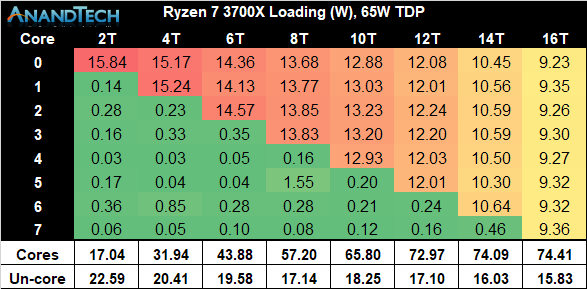
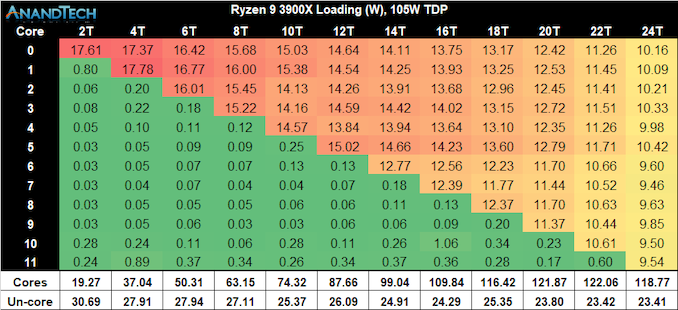
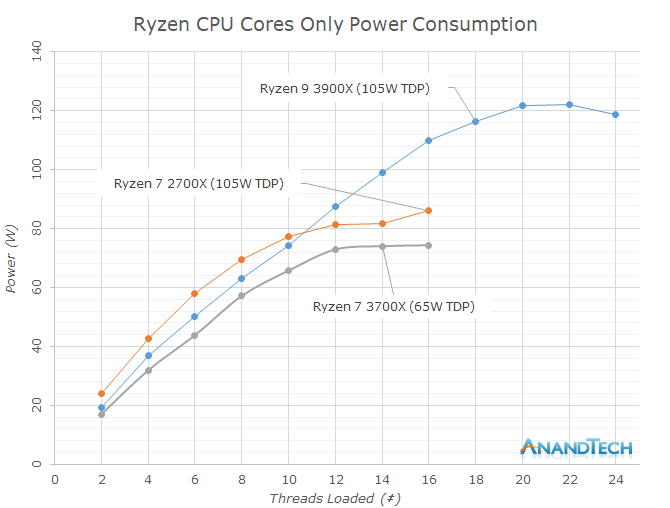








447 Comments
View All Comments
beginning - Thursday, July 11, 2019 - link
I noticed that at the E3 2019 tech day, AMD recommended DDR4-3600 CL16 RAM. I see that 3200 MHz RAM has been used in the AMD testbench. I read the description about avoiding overclocking but 3600 MHz RAMs come with a factory clock of 3600 MHz, right? I know I am missing something. What am I missing?sknaumov - Thursday, July 11, 2019 - link
Do you plan to make some tests of these CPUs on older, cheaper and colder motherboards? It would be very interesting to see results of b450 chipset and whether it is possible to use DDR4-3600MHz with tight timings on these older boards. Or at least provide more info about what has more priority for memory speed and timings on AMD platform - CPU or chipset.viperswhip - Thursday, July 11, 2019 - link
I am going to wait to build a PC for a bit, however, I am super excited by this launch and disappointed by the video card launch. I expect to have an AMD chip since Intel has no answer for this, and we shall see on the video cards, but if I was building today I'd probably get a 2070 RTX super.PProchnow - Friday, July 12, 2019 - link
Here's is Jus' a good ol' boy trying out. No OC off stock Multi but 3333Mhz RAM#1
https://browser.geekbench.com/v4/cpu/13863634
Rather a new rig and it is X470 up to the A.A BIOS and it is MSI Gaming Plus.
OK link #2 is here and I stroked the DDR$ up top 3333Mhz. I also stroked the fan
to stay sub 70C. Wild OCs will take water at least "in The Home" versus LiqN2 Lab.
https://browser.geekbench.com/v4/cpu/13865361
BTW where is the Bragging Thread? My MOBO is the MSI X470 Gaming Plus BIOS A.A makes Ryzen 9 go BTW.
I have yet to up the MULTI in case you want to know. I wonder what good Ocers will get with the right stuff.
Single-Core Performance
Memory Score 6431
Floating Point Score 5409
Integer Score 5190
Crypto Score 6888
Single-Core Score 5589
You underst and that RAM set at 1672 is 1/2 the common referred to speed. 3344Mhz is the common nomenclature.
***Single-Core Score ***Multi-Core Score
5589 47755
Geekbench 4.3.4 Tryout for Windows x86 (64-bit)
Result Information
Upload Date July 12 2019 08:16 PM
Views 2
System Information
System Information
Operating System Microsoft Windows 10 Pro (64-bit)
Model Micro-Star International Co., Ltd. MS-7B79
Motherboard Micro-Star International Co., Ltd. X470 GAMING PLUS (MS-7B79)
Memory 32768 MB DDR4 SDRAM 1672MHz
Northbridge AMD Ryzen SOC 00
Southbridge AMD X470 51
BIOS American Megatrends Inc. A.A0
Processor Information
Name AMD Ryzen 9 3900X
Topology 1 Processor, 12 Cores, 24 Threads
Identifier AuthenticAMD Family 23 Model 113 Stepping 0
Base Frequency 3.80 GHz
Maximum Frequency 4.53 GHz
Maxiking - Tuesday, July 23, 2019 - link
Why would anyone brag about something ifYou can't reach 5.0ghz +
You can't reach even the boost frequency on a single core
You can't beat consistently competitor's older 14nm cpu architecture which has been on the market since 2016...
You can't beat RAM OC'ing records either because over 3733mhz IF gets actually downlocked and due tu that, "faster" ram performs worse unless you OC 7400mhz, which is not possible even with liquid nitrogen.
PProchnow - Friday, July 12, 2019 - link
These are my scores with my Ryzen 9 3900X.#1
https://browser.geekbench.com/v4/cpu/13863634
Rather a new rig and it is X470 up to the A.A BIOS and it is MSI Gaming Plus.
OK link #2 is here and I stroked the DDR$ up top 3333Mhz. I also stroked the fan
to stay sub 70C. Wild OCs will take water at least "in The Home" versus LiqN2 Lab.
https://browser.geekbench.com/v4/cpu/13865361
BTW where is the Bragging Thread? My MOBO is the MSI X470 Gaming Plus BIOS A.A makes Ryzen 9 go BTW.
I have yet to up the MULTI in case you want to know. I wonder what good Ocers will get with the right stuff.
Single-Core Performance
Memory Score 6431
Floating Point Score 5409
Integer Score 5190
Crypto Score 6888
Single-Core Score 5589
You underst and that RAM set at 1672 is 1/2 the common referred to speed. 3344Mhz is the common nomenclature.
***Single-Core Score ***Multi-Core Score
5589 47755
Geekbench 4.3.4 Tryout for Windows x86 (64-bit)
Result Information
Upload Date July 12 2019 08:16 PM
Views 2
System Information
System Information
Operating System Microsoft Windows 10 Pro (64-bit)
Model Micro-Star International Co., Ltd. MS-7B79
Motherboard Micro-Star International Co., Ltd. X470 GAMING PLUS (MS-7B79)
Memory 32768 MB DDR4 SDRAM 1672MHz
Northbridge AMD Ryzen SOC 00
Southbridge AMD X470 51
BIOS American Megatrends Inc. A.A0
Processor Information
Name AMD Ryzen 9 3900X
Topology 1 Processor, 12 Cores, 24 Threads
Identifier AuthenticAMD Family 23 Model 113 Stepping 0
Base Frequency 3.80 GHz
Maximum Frequency 4.53 GHz
Now you can cross ref with others.
Meteor2 - Monday, July 15, 2019 - link
Nice!willis936 - Wednesday, July 17, 2019 - link
The editor's choice awards are a bit strange to me. Zen 1 didn't receive one even though it was the largest CPU performance increase from a company this century. The i7-4950HQ received an editor's choice silver award even though it had little importance to the industry. And the 3700X, which offers comparable SP performance to competing intel products at a huge discount and smaller power budget gets the same editor's choice level as the i7-4950HQ?willis936 - Wednesday, July 17, 2019 - link
I know it was a different editor at the time, but the selective excitement is a bit of a bummer. eDRAM was exciting to see at the time and then nothing ever came of it. The enthusiasm of chiplets under the new editor comes through much less. That too is fine. However if the rating system is what it is then I don't think it's much to argue that chiplets are much more disruptive than eDRAM and is already making much larger waves.Maxiking - Monday, July 22, 2019 - link
AMD fraund getting finally the attention it deserveshttps://www.youtube.com/watch?v=x03FyPQ3a3E
check at 05m25s